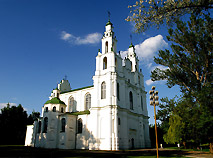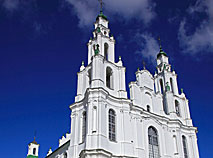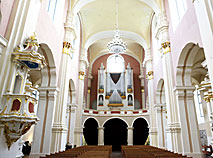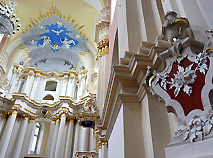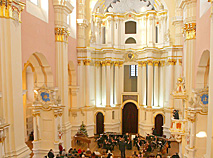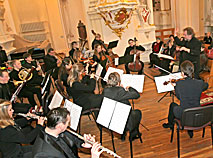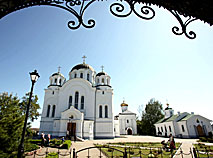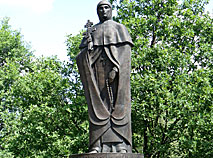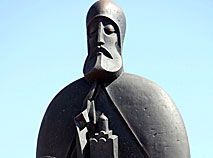Saint Sophia Cathedral in Polotsk
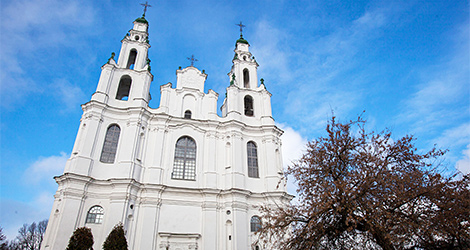
St. Sophia Cathedral in the ancient town of Polotsk does not look like other Eastern Orthodox churches of the same name. It is one of the oldest temples constructed by Eastern Slavonic peoples and the first church built from stone on the territory of Belarus.
This architectural specimen has been nominated for the UNESCO World Heritage List.
St. Sophia (Hagia Sophia) Cathedral is distinguished by remarkable and symbolic architecture. It was built on the right bank of the Western Dvina River in the 11th century. In the mid-18th century it was rebuilt to the design of architect Jan Krzysztof Glaubitz in the Vilna Baroque Style (Late Belarusian Baroque Style).
However, some elements of the original church survive to these days. They are fragments of masonry, the ancient foundation that remained virtually intact, a part of the apse, pillars and walls, and amazing frescos dating back to the second half of the 11th century. The cathedral still impresses onlookers by its stunning beauty and awe-inspiring grandeur.
It is noteworthy that an exact replica of the 11th century St. Sophia Cathedral is to be built in another famous Belarusian city - Vitebsk. The cathedral will also stand on the bank of the Western Dvina River.
History
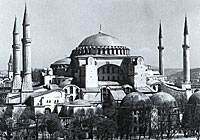 St. Sophia Cathedral in Polotsk was the third cathedral of this kind built in Ancient Rus and the fourth in the world. St. Sophia Cathedral in Polotsk like its “elder sisters” in Kiev and Novgorod was constructed to the same design as the famous Hagia Sophia Cathedral in Constantinople.
St. Sophia Cathedral in Polotsk was the third cathedral of this kind built in Ancient Rus and the fourth in the world. St. Sophia Cathedral in Polotsk like its “elder sisters” in Kiev and Novgorod was constructed to the same design as the famous Hagia Sophia Cathedral in Constantinople.
The Greek work “Sophia” means holy wisdom. However Polotsk residents understood it more broadly. For them the word meant human unity, solidarity of all people living in the Principality of Polotsk. The cathedral was first mentioned in The Life of St. Euphrosyne of Polotsk and The Tale of Igor’s Campaign of the 12th century.
This magnificent building was erected by Byzantine architects and local residents upon the order of Vseslav the Sorcerer in 1044-1066. Being a symbol of independence and power of the Principality of Polotsk, the temple resembled a white ship flowing along the Western Dvina River.
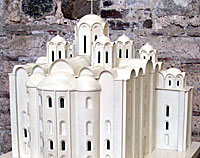 The design of the cathedral embrace both Byzantine and local architectural traditions. The cathedral was erected in the Upper Castle between the Prince’s dwellings and the mansion of the bishop, which emphasized the role of church in the country.
The design of the cathedral embrace both Byzantine and local architectural traditions. The cathedral was erected in the Upper Castle between the Prince’s dwellings and the mansion of the bishop, which emphasized the role of church in the country.
St. Sophia Cathedral in Polotsk became a religious, cultural and educational center. It accommodated a huge library, archives, treasury, magistrate, and halidoms. It was the place where diplomatic receptions were arranged. There was also a royal family vault in the cathedral. Archeologists discovered 16 sarcophagi there.
After the Union of Brest was signed in 1596, the cathedral was given to the Greek Catholic Church and reconstructed after the fires of 1607 and 1648. During the reconstruction, the upper part of corner defense towers of the church was removed upon the order of Archbishop Josaphat Kuntsevych.
During the Great Northern War Peter I ordered to use the cathedral as an ammunition warehouse. The cathedral was heavily damaged by an explosion in 1710.
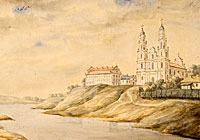 In the 18th century famous architect Jan Krzysztof Glaubitz rebuilt St. Sophia Cathedral in the Vilna Baroque style on the request of Archbishop of Polotsk Florian Hrebnicki.
In the 18th century famous architect Jan Krzysztof Glaubitz rebuilt St. Sophia Cathedral in the Vilna Baroque style on the request of Archbishop of Polotsk Florian Hrebnicki.
During the war of 1812 the sacred Orthodox halidom – the Cross of Euphrosyne of Polotsk - was kept in the wall of the cathedral, in a specially carved niche.
In 1913, the surviving frescos on the walls of the church were restored.
During the Great Patriotic War the cathedral housed a garrison church of the Nazi troops.
Architecture
The 11th-century St. Sofia Cathedral was a special piece of the ancient Russian architecture. The temples in Kiev, Novgorod and Polotsk have a similar cross-dome system, 5 naves, and galleries. But the Polotsk cathedral has its unique features such as:
-
bema, a raised area around the altar, formed by two posts (unusual for its time, used only in Bulgaria);
-
seven domes, symbolizing the seven Ecumenical church councils (St.Sophia Cathedral in Kiev has 13, the catheral in Novgorod - 5).
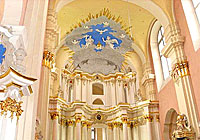 For the 11th century the St. Sophia Cathedral in Polotsk was a grandiose construction - 26.4m wide, 31.5m long and 31m high, the thickness of the walls reached 2.3 m.
For the 11th century the St. Sophia Cathedral in Polotsk was a grandiose construction - 26.4m wide, 31.5m long and 31m high, the thickness of the walls reached 2.3 m.
The Polotsk church acquired its modern look in the 18th century: the majestic one-apse Basilica with two bell towers overlooking the Dvina was built on the bank of the river to the design of Jan Glaubitz.
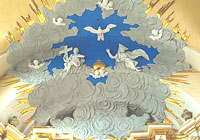 Splendid interior was complemented with baroque columns, mouldings and shaped cornices. The altar arch was decorated with the New Testament Trinity image, and the second and first tiers with wooden sculptures and paintings.
Splendid interior was complemented with baroque columns, mouldings and shaped cornices. The altar arch was decorated with the New Testament Trinity image, and the second and first tiers with wooden sculptures and paintings.
Some parts of the ancient frescos have survived, including the images of the Icon of Christ Not Made By Hands and a copy of Leonardo da Vinci's famous "Last Supper".
A big restoration project of the cathedral was conducted in the 1970s-1980s. The roof, facade and window openings were renovated in 2010-2013.
St. Sophia Cathedral Today
Today St. Sophia Cathedral is one of the major cultural centers of Belarus. It hosts religious services and ceremonies, excursions, concerts and recitals.
As a museum of architecture and a concert hall, St. Sophia is part of the Polotsk National Historical And Cultural Museum-Reserve.
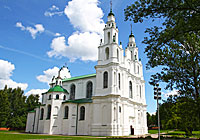 The museum of architecture of St. Sophia Cathedral was opened in 1987. The exhibition features rare exhibits telling about the history of the temple, its architecture and last restoration. Among them are fragments of the masonry of the 11th century, the foundation and fresco painting of the end of the 11th century.
The museum of architecture of St. Sophia Cathedral was opened in 1987. The exhibition features rare exhibits telling about the history of the temple, its architecture and last restoration. Among them are fragments of the masonry of the 11th century, the foundation and fresco painting of the end of the 11th century.
The museum offers audio-guides in Belarusian, Russian and English, a guide-book with the plan of the cathedral and a map of Polotsk.
In 1983 the concert hall of the cathedral which takes pride in its outstanding acoustics welcomed its first visitors. Organ has been played here since 1985.
Every year leading Belarusian and foreign musicians hold their unique cultural projects at St. Sophia Cathedral:
-
International Festival of Old and Modern Chamber Music (March-April);
-
International Festival of Organ Music St. Sophia’s Bells (November-December).
Organ music concerts are held every Sunday at 15.00 for tourists and music lovers (over 300 of them are held annually).
Visiting the Cathedral
The ancient temple lies on the bank of the Western Dvina River in Polotsk. Address: 1 Zamkovaya Street.
Places of Interest Near St. Sophia Cathedral
Next to the cathedral is Boris Stone of the 12th century, one of the four Belarusian boulders with engraved images of crosses and old inscriptions.
Many historical and architectural sites of the ancient Polotsk have survived to the present day. The majority of them are Orthodox sanctuaries. For example, a number of religious buildings have to do with Belarusian enlightener Euphrosyne of Polotsk:
-
The Monastery of Our Savior and St. Euphrosyne (12th – 20th centuries)
-
Savior Transfiguration Cathedral, which was built by architect John on Euphrosyne’s request in 1161. Today it is the oldest specimen of the Polotsk School of Architecture, where a great halidom – the Cross of Euphrosyne of Polotsk – can be found.
-
Refectory Church of St. Euphrosyne
Polotsk takes pride in its ancient buildings and monuments with an interesting history. Among them are:
-
The house of Peter I (33 Nizhne-Pokrovskaya Street), where the emperor stayed in the early 18th century;
-
Lutheran Protestant Church (19th – early 20th centuries). Today the building of the former neo-Gothic church hosts the city’s oldest Polotsk Local Lore Museum;
-
A monument to letter Ý (the letter of the Belarusian alphabet);
-
A monument to the Krivichi tribe;
-
Monuments to outstanding historical figures of Polotsk: Vseslav the Sorcerer, Saint Euphrosyne, Slavic First Printer Francysk Skorina, Simeon of Polotsk…
-
Red Bridge across the Polota River that witnessed a bloody battle between the Russian and French armies, and the monument to the heroes of the Patriotic War of 1812;
-
A memorial sign Polotsk – Europe’s Geographical Center (Francysk Skorina Avenue), where every visitor the city can get a certificate of the visit to Europe’s heart.







 print version
print version make home page
make home page add to bookmarks
add to bookmarks